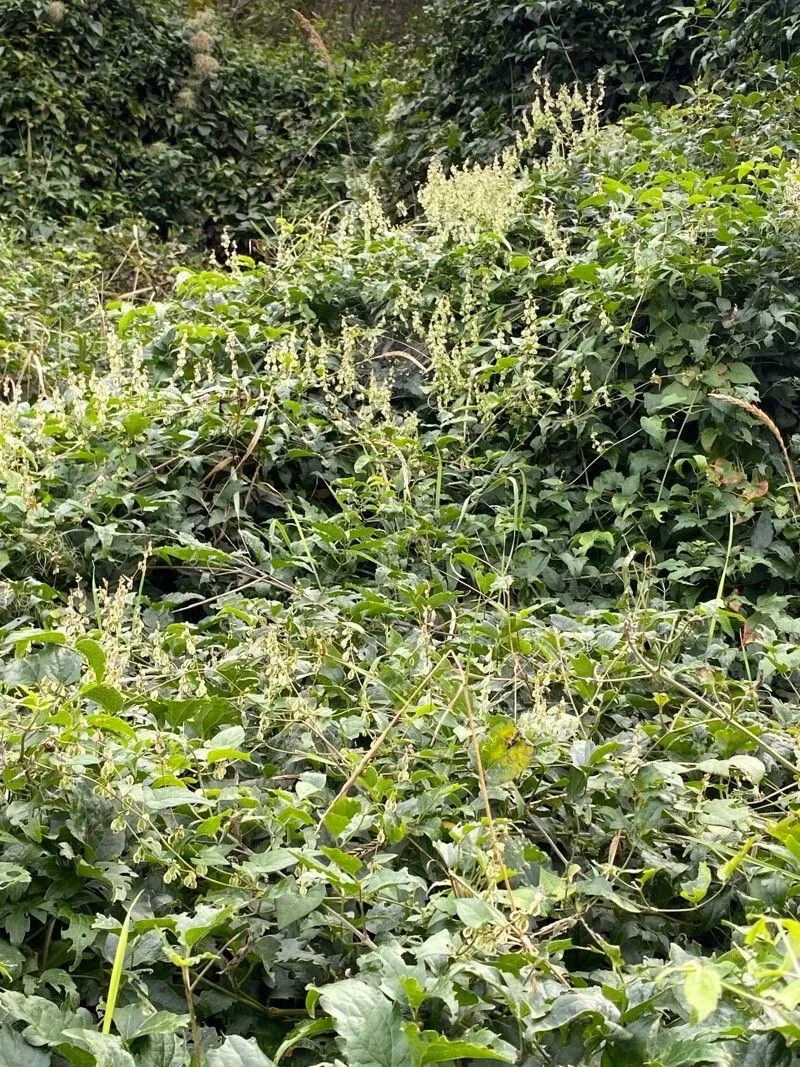
Author: (L.) Holub
Bibliography: Folia Geobot. Phytotax. 6: 176 (1971)
Year: 1971
Status: accepted
Rank: species
Genus: Fallopia
Vegetable: False
Observations: Temp. Eurasia
Copse-bindweed (Fallopia dumetorum)
Copse-bindweed, scientifically known as Fallopia dumetorum, is a notable member of the Polygonaceae family. This climbing plant is renowned for its vigorous growth and ability to entwine itself around surrounding vegetation, forming dense thickets in hedgerows, woodlands, and other natural habitats across temperate regions of Eurasia.
Described in detail by (L.) Holub in the publication “Folia Geobotanica et Phytotaxonomica” in 1971, Copse-bindweed exhibits characteristic features that make it easily identifiable. The plant’s slender, twining stems can extend several meters in length, efficiently wrapping around other plants and structures to reach for sunlight.
The leaves of Fallopia dumetorum are typically heart-shaped, with smooth edges and pointed tips. These leaves provide the necessary photosynthetic surface area for the plant’s energy production, while also serving as subtle indicators of its presence within its habitat.
One of the most striking aspects of Copse-bindweed is its floral structure. The plant produces small, tubular flowers that cluster together in racemes. These flowers, often white or pale pink, bloom during the late summer months, adding a delicate touch of color to the green surroundings. Each blossom is a vital component of the plant’s reproduction process, eventually giving way to small, triangular seeds that ensure the propagation of the species.
Ecologically, Fallopia dumetorum plays an essential role within its environment. Its dense growth provides shelter and protective cover for various wildlife, while also contributing to the structural complexity of the underbrush in wooded areas. However, its aggressive growth pattern requires management in certain contexts to prevent it from overpowering and potentially displacing other native vegetation.
In summary, Copse-bindweed or Fallopia dumetorum is an intriguing and ecologically significant plant found across temperate Eurasia. Its robust climbing ability, heart-shaped leaves, and delicate flowers make it a distinctive member of the Polygonaceae family, contributing both beauty and complexity to its natural habitat.
Eng: climbing false buckwheat, copse-bindweed, desert knotgrass, hedge bindweed, copse bindweed, hedge smartweed
Deu: hechen-flügelknöterich, hecken-knöterich, hecken-windenknöterich, heckenknöterich
Fra: renouée des haies, grande vrillée, vrillée des buissons
Dan: vinge-pileurt
Nld: heggenduizendknoop
Nob: krattslirekne
Nno: krattslirekne
Swe: lövbinda, pensaikkotatar
Fin: pensaikkotatar
Por: polígono-trepador
Sme: miesttadáđir
Cym: clymog y berth
En: Copse-bindweed, Desert knotgrass, Corpse Black-Bindweed, Climbing false buckwheat, Hedge bindweed, Copse bindweed, Hedge smartweed, Copse-binweed
Be: Драсён каляплотавы
Ca: Fajol de bardissa
Zh: Li shou wu, 篱蓼
Cs: Opletka křovištní
Da: Vinge-pileurt
Nl: Heggenduizendknoop, Heggeduizendknoop
Et: Võsa-konnatatar
Fi: Pensaikkotatar
Fr: Renouée des haies, Grande vrillée, Vrillée des buissons
De: Hechen-Flügelknöterich, Hecken-Flügelknöterich, Heckenknöterich, Hecken-Knöterich, Hecken-Windenknöterich
It: Poligono delle siepi
Ja: Tsuru-itadori, Tsuru-tade
Ko: 닭의덩굴
Lv: Krūmāja vējgriķis
Se: Miesttadáđir
Nb: Krattslirekne
Nn: Krattslirekne
Pt: Polígono-trepador
Es: Polígono trepador
Sv: Lövbinda, Pensaikkotatar
Cy: Clymog y Berth
Taken Sep 14, 2022 by Fabrice Rubio (cc-by-sa)
Taken Aug 24, 2021 by Sabina Hartmann (cc-by-sa)
Taken Sep 15, 2022 by Jacques Zuber (cc-by-sa)
Taken Sep 3, 2022 by Andrzej Konstantynowicz (cc-by-sa)
Taken Oct 24, 2022 by Fabrice Rubio (cc-by-sa)
Taken Jun 28, 2022 by Leo S. (cc-by-sa)
Taken Nov 6, 2019 by Ettedgui Bianca (cc-by-sa)
Taken Sep 3, 2022 by Andrzej Konstantynowicz (cc-by-sa)
Taken Sep 3, 2022 by Andrzej Konstantynowicz (cc-by-sa)
Taken Oct 24, 2022 by Fabrice Rubio (cc-by-sa)
Taken Oct 24, 2022 by Fabrice Rubio (cc-by-sa)
Taken Sep 11, 2016 by Yoan MARTIN (cc-by-sa)
Taken Sep 3, 2022 by Andrzej Konstantynowicz (cc-by-sa)
Taken Jan 30, 2021 by Jordan Wegberg (cc-by-sa)
Taken Nov 6, 2019 by Ettedgui Bianca (cc-by-sa)
Taken Sep 17, 2022 by Malte (cc-by-sa)
Taken Sep 27, 2020 by Mertens Ulrich (cc-by-sa)
Taken Sep 15, 2022 by Jacques Zuber (cc-by-sa)
Taken Sep 15, 2022 by Jacques Zuber (cc-by-sa)
Taken Oct 2, 2022 by kal l (cc-by-sa)
Taken Apr 8, 2020 by Bernard Lhote (cc-by-sa)
Taken Nov 14, 2020 by benjamin blum (cc-by-sa)
Taken Sep 13, 2011 by Martin Bishop (cc-by-sa)
Taken Oct 24, 2022 by Fabrice Rubio (cc-by-sa)
Taken Sep 15, 2007 by Photoflora – Jean-Luc TASSET (©)
Taken Aug 16, 2019 by w jessie (cc-by-sa)
Taken Sep 9, 2021 by Rico Mende (cc-by-sa)
Taken Sep 11, 2022 by Mati (cc-by-sa)
Taken Sep 9, 2021 by Rico Mende (cc-by-sa)
© copyright of the Board of Trustees of the Royal Botanic Gardens, Kew.
Ph maximum: 7.0
Ph minimum: 6.5
Light: 6
Atmospheric humidity: 5
Bloom months: [‘jun’, ‘jul’, ‘aug’, ‘sep’, ‘oct’]
Soil nutriments: 7
Family: Myrtaceae Author: (F.Muell.) K.D.Hill & L.A.S.Johnson Bibliography: Telopea 6: 402 (1995) Year: 1995 Status:…
Family: Rubiaceae Author: Pierre ex A.Froehner Bibliography: Notizbl. Bot. Gart. Berlin-Dahlem 1: 237 (1897) Year:…
Family: Sapindaceae Author: Koidz. Bibliography: J. Coll. Sci. Imp. Univ. Tokyo 32(1): 38 (1911) Year:…
Family: Asteraceae Author: A.Gray Bibliography: Pacif. Railr. Rep.: 107 (1857) Year: 1857 Status: accepted Rank:…
Family: Fabaceae Author: Medik. Bibliography: Vorles. Churpfälz. Phys.-Ökon. Ges. 2: 398 (1787) Year: 1787 Status:…
Family: Aspleniaceae Author: (Cav.) Alston Bibliography: Bull. Misc. Inform. Kew 1932: 309 (1932) Year: 1932…